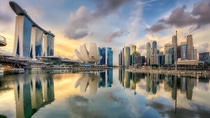Chi siamo
Charting new waters

These three cities are leading the way toward water systems of the future.
Phnom Penh, Cambodia
Average rainfall: 1,300 millimeters per year; population: 1.5 million; daily water consumption per person: 108 liters
When Ek Sonn Chan was appointed general director of the Phnom Penh Water Supply Authority in 1993, he encountered a sobering situation: The utility company was only able to supply 65,000 cubic meters of water daily – not even half of its actual capacity. The pipeline system was dilapidated, corruption was rampant and more than 70% of the water was not generating any revenue. Because water was leaking from the system, people were tapping into the pipelines illegally and invoices were simply not being paid, the water authority had barely any income. With international support, Chan successfully updated the technical infrastructure and introduced modern management practices. Today every household has access to clean water. Water meters have been installed throughout the city and the pipes are inspected regularly. The water utility, which has now become a joint stock company, generates a profit every year. For these reforms, Ek Sonn Chan and his team won the 2010 Stockholm Industry Water Award from the Stockholm Water Foundation.


Lima, Peru
Average rainfall: less than 15 millimeters per year; population: 8.5 million; daily water consumption per person: 250 liters
More than one million residents of Lima, the capital city of Peru, have no access to clean drinking water. The Rímac, a river that flows from the Andes, has long been the main source of the city’s water supply. Now the city wants to create new reservoirs. Since 2012, the Huascacocha reservoir, located around 100 kilometers from the megacity, has been delivering 273,000 cubic meters of water per day to Lima. It is part of a modernization program started in 2009 by the water utility Sedapal. The utility also plans to invest a total of $1.5 billion (€1.1 billion) in projects such as desalination plants, additional reservoirs in the Andes and transferring water from neighboring catchment areas into the Rímac. Sedapal is also trying to limit water wastage. Currently, up to 45% of water in Lima is lost through leaky pipes. Water meters are being installed so administrative losses can be discovered and reduced. The meters will also give Lima residents a clear picture of the value of water because, with a consumption rate of 250 liters per capita each day, they are at the top end of the scale of global water consumption.
City-state Singapore
Average rainfall: 2,400 millimeters per year; population: 5.3 million; daily water consumption per person: 152 liters
Although Singapore is surrounded by water, drinking water here is scarce. The water issue was therefore declared a priority as early as the 1960s. Singapore’s creative methods of handling this resource can be seen in the NEWater visitor center located at Marina Barrage. Completed in 2008, Marina Barrage was designed as a reservoir for rainwater and has now become an important source of drinking water. Singapore’s national water agency PUB takes a four-pronged approach to water management: precipitation water, wastewater recycling, seawater desalination and water imports from Malaysia. The gem among these is the recycling program for urban wastewater, known as NEWater. It is treated in a three-stage process which results in water that is of even better quality than the normal drinking water, according to PUB. With a capacity of 273,000 cubic meters per day, NEWater now meets about 30% of the urban water demand. By 2060, this share should rise as high as 55%. Furthermore, conservation initiatives encourage residents to save water.




